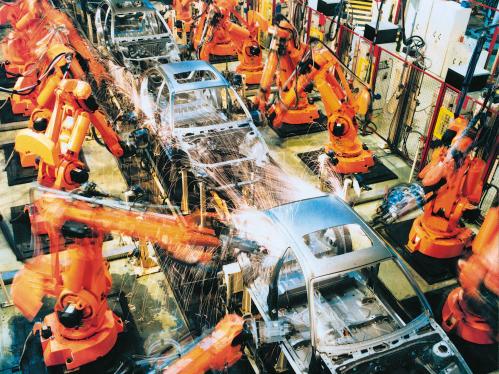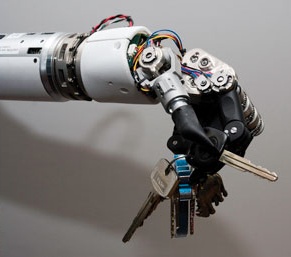Return to MODULE PAGE
Kinds of Robots
Jeremy Gottlieb: Author
David Leech Anderson: Author
I. Pre-Programmed Robots
 Pre-programmed robots operate in a simple, controlled environment so that they do not require a great deal in the way of intelligent control systems ("aritificial intelligence") to operate successfully. The most familiar pre-programmed robots are problably the robots used to build cars in most automobile plants around the world. There are similar robots that operate not on cars, but on the human body. Learn more about pre-programmed robots in both industry and in the medical field.
Pre-programmed robots operate in a simple, controlled environment so that they do not require a great deal in the way of intelligent control systems ("aritificial intelligence") to operate successfully. The most familiar pre-programmed robots are problably the robots used to build cars in most automobile plants around the world. There are similar robots that operate not on cars, but on the human body. Learn more about pre-programmed robots in both industry and in the medical field.
II. Autonomous Robots
Autonomous robots operate independently of human operators in environments that are not as tightly controlled as pre-programmed robots. They have "autonomy" because it is ultimatley the machine's responsibility to detet changes in the environment and to adapt to it. When operating properly it is not necessary for humans to constantly monitor and manipulate the enviornment to accommodate limitations in the robot's ability to cope. Autonomous robots are used in industry, as labor-saving devices at home, and are even becoming popular toys.
in environments that are not as tightly controlled as pre-programmed robots. They have "autonomy" because it is ultimatley the machine's responsibility to detet changes in the environment and to adapt to it. When operating properly it is not necessary for humans to constantly monitor and manipulate the enviornment to accommodate limitations in the robot's ability to cope. Autonomous robots are used in industry, as labor-saving devices at home, and are even becoming popular toys.
III. Teleoperated Robots
 Teleoperated robots are controlled remotely by a human being. The underwater robots that helped fix the oil leak in the Gulf of Mexico were teleoperated. The robotic arm on the Space Shuttle is another example. There are many such examples with the number and kind of robots growing with each passing year. Special emphasis will be given to the use of such robots in the medical field. It is now possible for your physician to be tele-present in your home town, even if she is on a trip to China.
Teleoperated robots are controlled remotely by a human being. The underwater robots that helped fix the oil leak in the Gulf of Mexico were teleoperated. The robotic arm on the Space Shuttle is another example. There are many such examples with the number and kind of robots growing with each passing year. Special emphasis will be given to the use of such robots in the medical field. It is now possible for your physician to be tele-present in your home town, even if she is on a trip to China.
IV. Augmenting Robots
Some robots are connected directly to the human user's body, either by the  user gripping the controls in their hand or by having it in contact witj the user's body in some other way. Movements of the users body (sometimes it is only the mental activity of the user's brain) ultimately control a robotic effector of some kind. These robots can either enhance the user's natural skill in some way (e.g., extending their reach) or give them a skill they don't have or have lost (e.g., a robotic prosthetic arm). These robots can give humans the lifting power of giants and the dexterity of a virtuoso surgeon.
user gripping the controls in their hand or by having it in contact witj the user's body in some other way. Movements of the users body (sometimes it is only the mental activity of the user's brain) ultimately control a robotic effector of some kind. These robots can either enhance the user's natural skill in some way (e.g., extending their reach) or give them a skill they don't have or have lost (e.g., a robotic prosthetic arm). These robots can give humans the lifting power of giants and the dexterity of a virtuoso surgeon.




